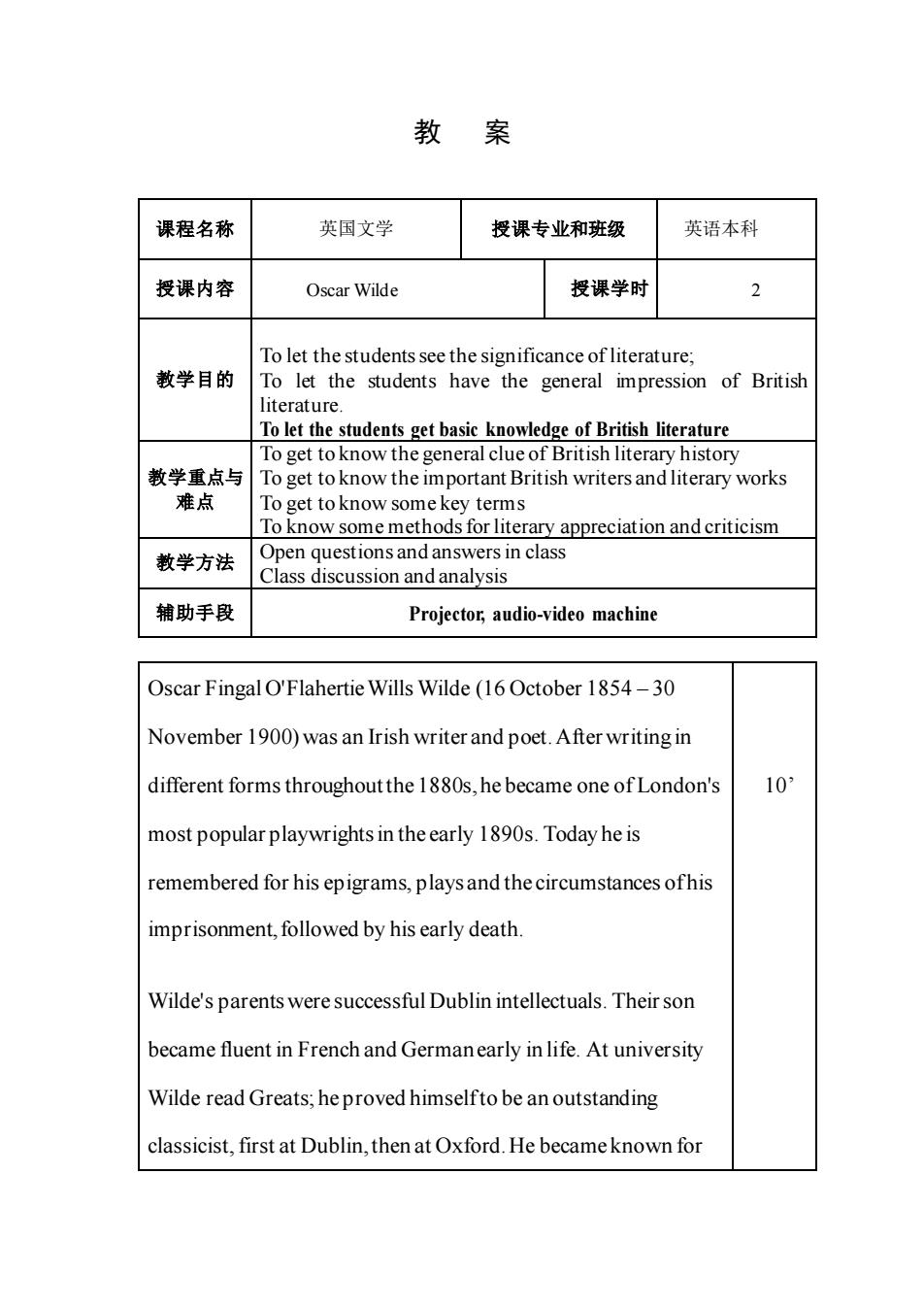
教案 课程名称 英国文学 授课专业和班级 英语本科 授课内容 Oscar Wilde 授课学时 To let the students see the significance of literature; 教学目的 To let the students have the general impression of British To let the students get basic knowledge of British literature To get to know the general clue of British literary history 教学重点与To get to know the important British writers and literary works 难点 To get toknow some key terms Toknowsome methods for literary 教学方法 Open questions and answers in class Class discussion and analysis 辅助手段 Projector,audio-video machine Oscar Fingal O'Flahertie Wills Wilde(16 October 1854-30 November 1900)was an Irish writer and poet.After writing in different forms throughout the 1880s,he became one of London's 101 most popular playwrights in the early 1890s.Today he is remembered for his epigrams,playsand the circumstances ofhis imprisonment,followed by his early death. Wilde's parents were successful Dublin intellectuals.Their son became fluent in French and Germanearly in life.At university Wilde read Greats;he proved himselfto be an outstanding classicist,first at Dublin,then at Oxford.He became known for
教 案 课程名称 英国文学 授课专业和班级 英语本科 授课内容 Oscar Wilde 授课学时 2 教学目的 To let the students see the significance of literature; To let the students have the general impression of British literature. To let the students get basic knowledge of British literature 教学重点与 难点 To get to know the general clue of British literary history To get to know the important British writers and literary works To get to know some key terms To know some methods for literary appreciation and criticism 教学方法 Open questions and answers in class Class discussion and analysis 辅助手段 Projector, audio-video machine Oscar Fingal O'Flahertie Wills Wilde (16 October 1854 – 30 November 1900) was an Irish writer and poet. After writing in different forms throughout the 1880s, he became one of London's most popular playwrights in the early 1890s. Today he is remembered for his epigrams, plays and the circumstances of his imprisonment, followed by his early death. Wilde's parents were successful Dublin intellectuals. Their son became fluent in French and German early in life. At university Wilde read Greats; he proved himself to be an outstanding classicist, first at Dublin, then at Oxford. He became known for 10’
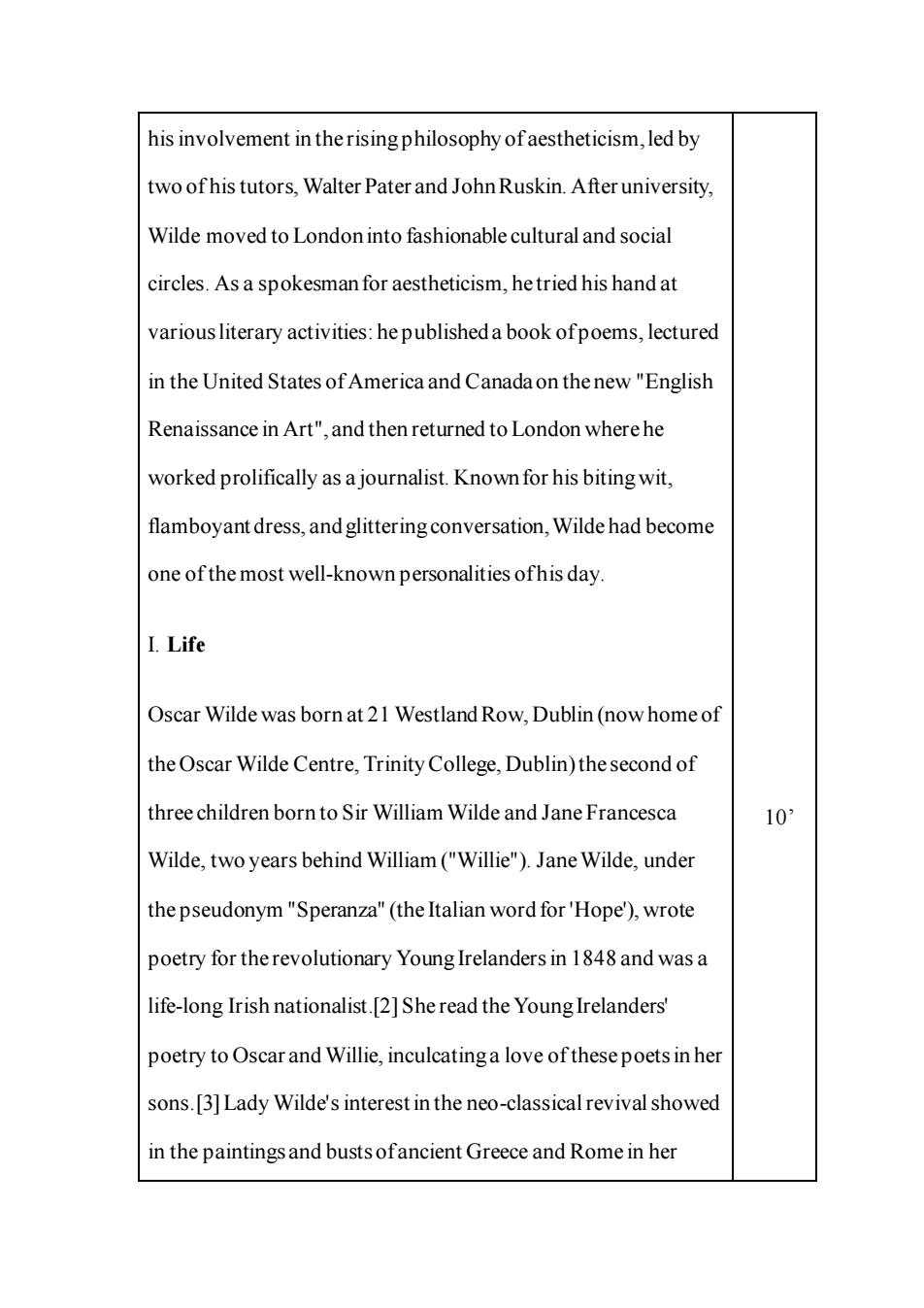
his involvement in therisingphilosophy ofaestheticism,led by two ofhis tutors,Walter Pater and John Ruskin.After university, Wilde moved to London into fashionable cultural and social circles.As a spokesman for aestheticism,hetried his hand at various literary activities:he published a book ofpoems,lectured in the United States of America and Canadaon the new "English Renaissance in Art",and then returned to London where he worked prolifically as a journalist.Known for his biting wit, flamboyant dress,and glittering conversation,Wilde had become one ofthe most well-known personalities ofhis day. I.Life Oscar Wilde was born at 21 Westland Row,Dublin (now home of the Oscar Wilde Centre,Trinity College,Dublin)the second of three children born to Sir William Wilde and Jane Francesca 10 Wilde,two years behind William("Willie").Jane Wilde,under the pseudonym "Speranza"(the Italian word for'Hope'),wrote poetry for the revolutionary Young Irelanders in 1848 and was a life-long Irish nationalist.[2]She read the Young Irelanders' poetry to Oscar and Willie,inculcatinga love of these poets in her sons.[3]Lady Wilde's interest in the neo-classical revival showed in the paintingsand busts ofancient Greece and Rome in her
his involvement in the rising philosophy of aestheticism, led by two of his tutors, Walter Pater and John Ruskin. After university, Wilde moved to London into fashionable cultural and social circles. As a spokesman for aestheticism, he tried his hand at various literary activities: he published a book of poems, lectured in the United States of America and Canada on the new "English Renaissance in Art", and then returned to London where he worked prolifically as a journalist. Known for his biting wit, flamboyant dress, and glittering conversation, Wilde had become one of the most well-known personalities of his day. I. Life Oscar Wilde was born at 21 Westland Row, Dublin (now home of the Oscar Wilde Centre, Trinity College, Dublin) the second of three children born to Sir William Wilde and Jane Francesca Wilde, two years behind William ("Willie"). Jane Wilde, under the pseudonym "Speranza" (the Italian word for 'Hope'), wrote poetry for the revolutionary Young Irelandersin 1848 and was a life-long Irish nationalist.[2] She read the Young Irelanders' poetry to Oscar and Willie, inculcating a love of these poets in her sons.[3]Lady Wilde's interest in the neo-classical revival showed in the paintings and busts of ancient Greece and Rome in her 10’
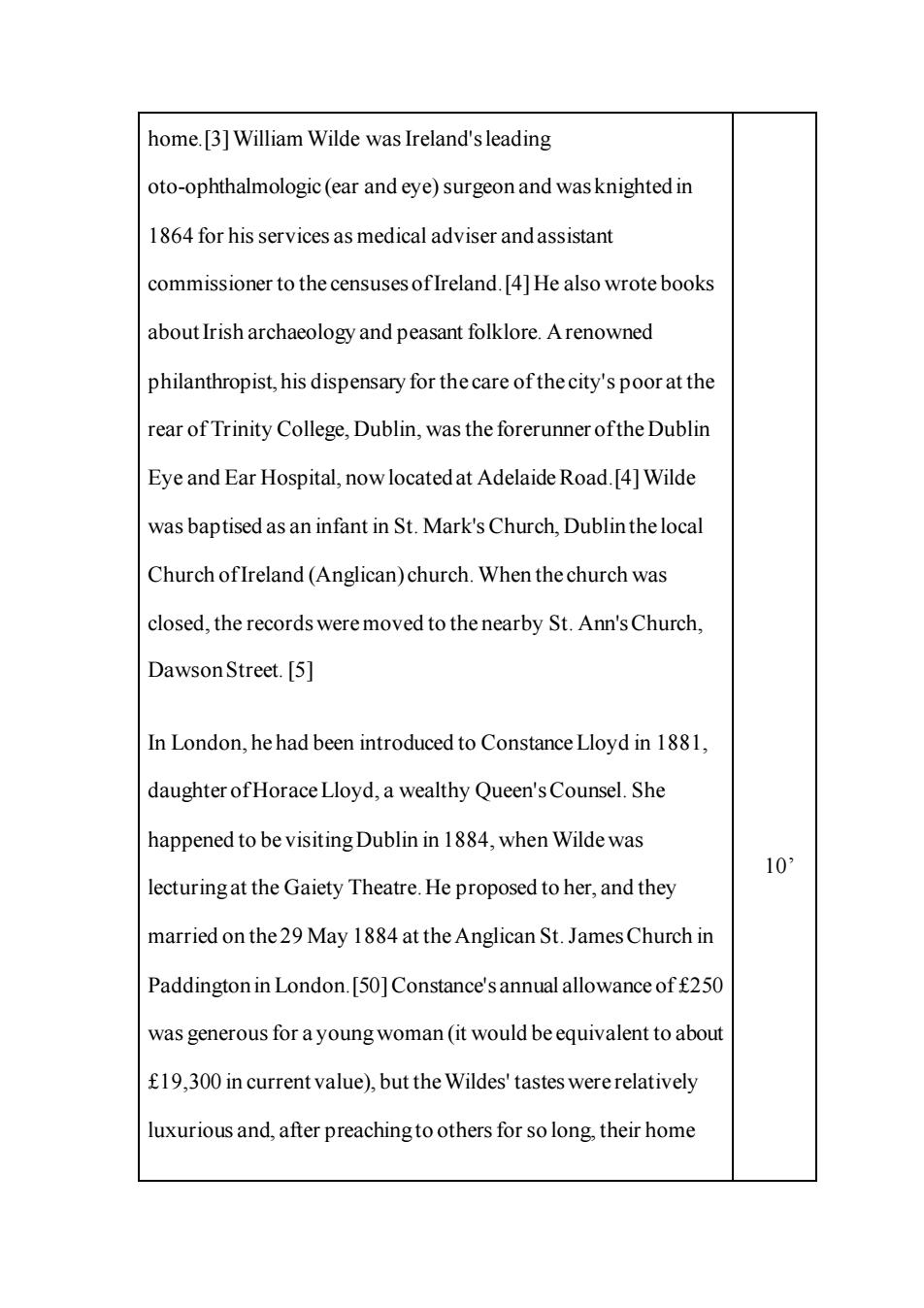
home.[3]William Wilde was Ireland's leading oto-ophthalmologic(ear and eye)surgeon and was knighted in 1864 for his services as medical adviser and assistant commissioner to the censusesofIreland.[4]He also wrote books about Irish archaeology and peasant folklore.Arenowned philanthropist,his dispensary for the care ofthecity's poor at the rear of Trinity College,Dublin,was the forerunner ofthe Dublin Eye and Ear Hospital,now located at Adelaide Road.[4]Wilde was baptised as an infant in St.Mark's Church,Dublin the local Church ofIreland(Anglican)church.When the church was closed,the records were moved to the nearby St.Ann's Church. Dawson Street.[5] In London,he had been introduced to Constance Lloyd in 1881, daughter ofHorace Lloyd,a wealthy Queen's Counsel.She happened to be visiting Dublin in 1884,when Wilde was 10 lecturingat the Gaiety Theatre.He proposed to her,and they married on the29 May 1884 at the Anglican St.James Church in Paddington in London.[50]Constance's annual allowance of f250 was generous for a young woman(it would be equivalent to about 19,300 in current value),but the Wildes'tastes wererelatively luxurious and,after preachingto others for so long,their home
home.[3]William Wilde was Ireland's leading oto-ophthalmologic (ear and eye) surgeon and was knighted in 1864 for his services as medical adviser and assistant commissioner to the censuses of Ireland.[4]He also wrote books about Irish archaeology and peasant folklore. A renowned philanthropist, his dispensary for the care of the city's poor at the rear of Trinity College, Dublin, was the forerunner of the Dublin Eye and Ear Hospital, now located at Adelaide Road.[4]Wilde was baptised as an infant in St. Mark's Church, Dublin the local Church of Ireland (Anglican) church. When the church was closed, the records were moved to the nearby St. Ann's Church, Dawson Street. [5] In London, he had been introduced to Constance Lloyd in 1881, daughter of Horace Lloyd, a wealthy Queen's Counsel. She happened to be visiting Dublin in 1884, when Wilde was lecturing at the Gaiety Theatre. He proposed to her, and they married on the 29 May 1884 at the Anglican St. James Church in Paddington in London.[50]Constance's annual allowance of £250 was generous for a young woman (it would be equivalent to about £19,300 in current value), but the Wildes' tastes were relatively luxurious and, after preaching to others for so long, their home 10’
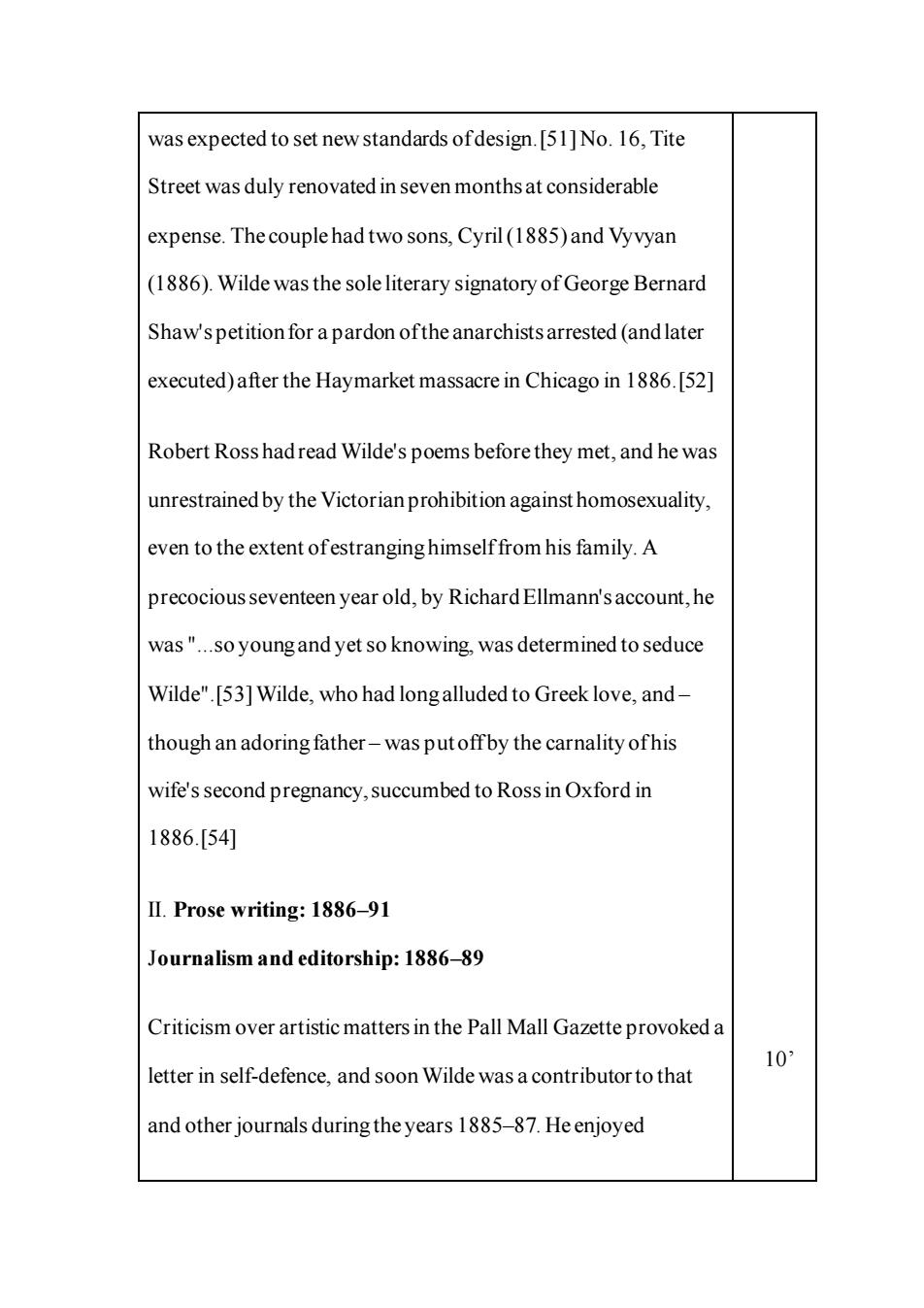
was expected to set new standards ofdesign.[51]No.16,Tite Street was duly renovated in seven months at considerable expense.Thecouple had two sons,Cyril(1885)and Vyvyan (1886).Wilde was the sole literary signatory of George Bernard Shaw's petition for a pardon ofthe anarchists arrested(and later executed)after the Haymarket massacre in Chicago in 1886.[52] Robert Ross hadread Wilde's poems before they met,and he was unrestrained by the Victorian prohibition against homosexuality. even to the extent ofestranginghimselffrom his family.A precocious seventeen year old,by Richard Ellmann'saccount,he was".so youngand yet so knowing,was determined to seduce Wilde".[53]Wilde,who had long alluded to Greek love,and- though an adoring father-was put offby the carnality ofhis wife's second pregnancy,succumbed to Ross in Oxford in 1886.[54 II.Prose writing:1886-91 Journalism and editorship:1886-89 Criticism over artistic matters in the Pall Mall Gazette provoked a letter in self-defence,and soon Wilde was a contributor to that 10 and other journals duringthe years 1885-87.He enjoyed
was expected to set new standards of design.[51]No. 16, Tite Street was duly renovated in seven months at considerable expense. The couple had two sons, Cyril(1885) and Vyvyan (1886). Wilde was the sole literary signatory of George Bernard Shaw's petition for a pardon of the anarchists arrested (and later executed) after the Haymarket massacre in Chicago in 1886.[52] Robert Ross had read Wilde's poems before they met, and he was unrestrained by the Victorian prohibition against homosexuality, even to the extent of estranging himself from his family. A precocious seventeen year old, by Richard Ellmann's account, he was ".so young and yet so knowing, was determined to seduce Wilde".[53]Wilde, who had long alluded to Greek love, and – though an adoring father – was put off by the carnality of his wife's second pregnancy, succumbed to Ross in Oxford in 1886.[54] II. Prose writing: 1886–91 Journalism and editorship: 1886–89 Criticism over artistic matters in the Pall Mall Gazette provoked a letter in self-defence, and soon Wilde was a contributor to that and other journals during the years 1885–87. He enjoyed 10’
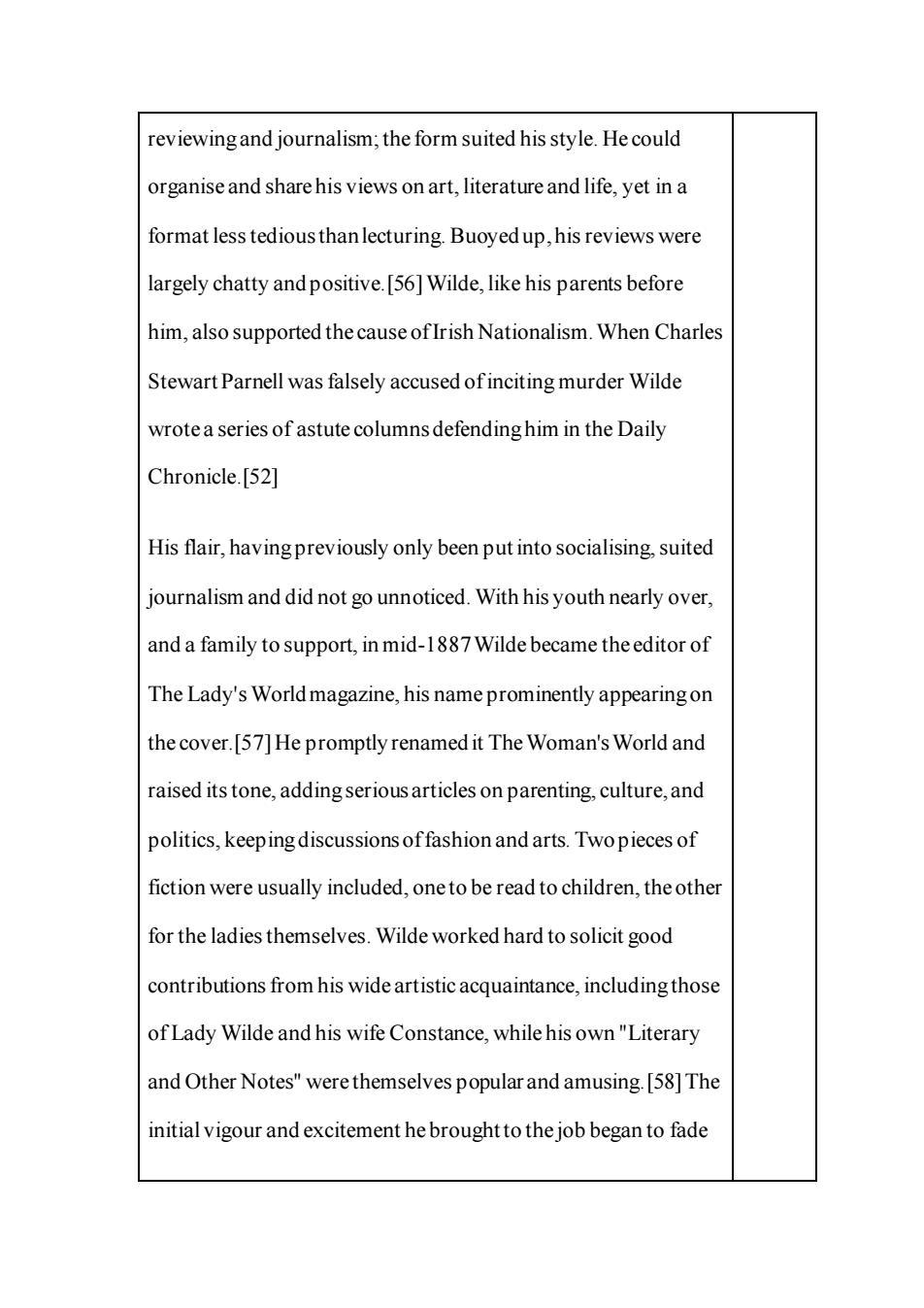
reviewingand journalism;the form suited his style.He could organise and share his views on art,literature and life,yet in a format less tedious thanlecturing.Buoyedup,his reviews were largely chatty andpositive.[56]Wilde,like his parents before him,also supported the cause ofIrish Nationalism.When Charles Stewart Parnell was falsely accused ofinciting murder Wilde wrotea series of astute columnsdefendinghim in the Daily Chronicle.[52] His flair,havingpreviously only been put into socialising,suited journalism and did not go unnoticed.With his youth nearly over, and a family to support,in mid-1887 Wilde became theeditor of The Lady's World magazine,his name prominently appearingon the cover.[57]He promptly renamed it The Woman's World and raised its tone,adding seriousarticles on parenting,culture,and politics,keeping discussions offashion and arts.Two pieces of fiction were usually included,one to be read to children,the other for the ladies themselves.Wilde worked hard to solicit good contributions from his wide artistic acquaintance,includingthose of Lady Wilde and his wife Constance,while his own"Literary and Other Notes"were themselves popular and amusing.[58]The initial vigour and excitement he broughtto thejob began to fade
reviewing and journalism; the form suited his style. He could organise and share his views on art, literature and life, yet in a format less tedious than lecturing. Buoyed up, his reviews were largely chatty and positive.[56]Wilde, like his parents before him, also supported the cause of Irish Nationalism. When Charles Stewart Parnell was falsely accused of inciting murder Wilde wrote a series of astute columns defending him in the Daily Chronicle.[52] His flair, having previously only been put into socialising, suited journalism and did not go unnoticed. With his youth nearly over, and a family to support, in mid-1887 Wilde became the editor of The Lady's World magazine, his name prominently appearing on the cover.[57] He promptly renamed it The Woman's World and raised its tone, adding serious articles on parenting, culture, and politics, keeping discussions of fashion and arts. Two pieces of fiction were usually included, one to be read to children, the other for the ladies themselves. Wilde worked hard to solicit good contributions from his wide artistic acquaintance, including those of Lady Wilde and his wife Constance, while his own "Literary and Other Notes" were themselves popular and amusing.[58]The initial vigour and excitement he brought to the job began to fade